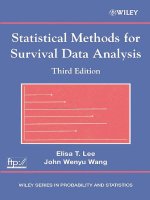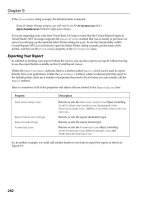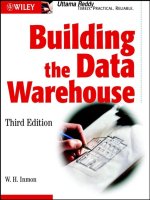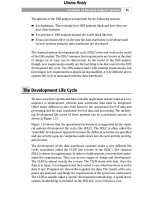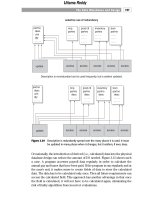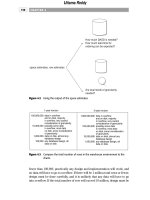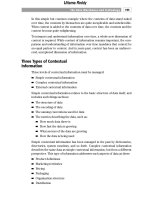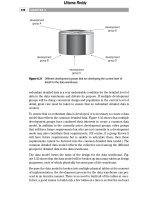Statistical Methods for Survival Data Analysis Third Edition phần 9 pptx
Bạn đang xem bản rút gọn của tài liệu. Xem và tải ngay bản đầy đủ của tài liệu tại đây (1.17 MB, 54 trang )
model y : sbp linsul
/ ml covb;
contrast ‘Equal coefficients for SBP’ all
—
parms 0 0 1 9100;
contrast ‘Equal coefficients for LINSUL’ all
—
parms 0000191;
run;
SPSS code:
data list file : ‘c:!ex14d2d6.dat’ free
/ age ageg sex sbp dbp lacr hdl linsul smoke dms dm sn.
Compute y : 4-dms.
nomreg y with sbp linsul
/print : fit history parameter lrt.
BMDP PR code:
/input file : ‘c:!ex14d2d6.dat’ .
variables : 12.
format : free.
/variable names : age, ageg, sex, sbp, dbp, lacr, hdl, linsul, smoke,
dms, dm, sn.
Use : age, sex to smoke.
/transform y : 4-dms.
/group codes(y) : 1, 2, 3.
Names(y) : DM, IFG, NFG.
/regress depend : y.
Level : 3.
Type : nom.
Interval : age, sex to smoke.
enter : .05, .05.
remove ::.05, .05.
/print cell : model.
/end
14.3.2 Model for Ordinal Polychotomous Outcomes:
Ordinal Regression Models
If the outcomes involve a rank ordering, that is, the outcome variable is
ordinal, several multivalued regression models are available. Readers interested
in these models are referred to McCullagh and Nelder (1989), Agresti (1990),
Ananth and Kleinbaum (1997), and Hosmer and Lemeshow (2000). In the
following discussion, we introduce the most frequently used model, the propor-
tional odds model. In this model, the probability of an outcome below or equal
to a given ordinal level, P(Y - k), is compared to the probability that it is
higher than the level given, P(Y 9k).
Let Y
G
be the outcome of the ith subject. Assume that Y
G
can be classified into
m ordinal levels. Let Y
G
: k if Y
G
is classified into the kth level and
419
k : 1, 2, , m. Suppose that for each of n subjects, p independent variables
x
G
: (x
G
, x
G
, , x
GN
) are measured. These variables can be either qualitative
or quantitative. If the logit link function defined in Section 14.2.3 is used, similar
to the logistic regression model (14.2.3), we consider the following models:
logit(P(Y
G
- k "x
G
)) : log
P(Y
G
-k " x
G
)
1 9 P(Y
G
- k "x
G
)
: a
I
;
N
H
b
H
x
GH
k : 1, 2, , m 9 1 (14.3.5)
or, equivalently, let u
IG
: a
I
;
N
H
b
H
x
GH
,
P(Y
G
- k "x
G
) :
exp(a
I
;
N
H
b
H
x
GH
)
1 ; exp(a
I
;
N
H
b
H
x
GH
)
:
exp(u
IG
)
1 ; exp(u
IG
)
k : 1, 2, , m 9 1 (14.3.6)
Therefore,
P(Y
G
: k " x
G
) : P(Y
G
- k "x
G
) 9 P(Y
G
- k 9 1" x
G
)
:
exp(u
G
)
1 ;exp(u
G
)
k : 1
exp(u
IG
)
1 ;exp(u
IG
)
9
exp(u
I\G
)
1 ; exp(u
I\G
)
k : 2, , m 9 1
1 9
exp(u
K\G
)
1 ; exp(u
K\G
)
k : m
(14.3.7)
If m : 2, that is, there are only two outcome levels, (14.3.7) reduces to the
logistic regression model in (14.2.3). The models in (14.3.5) can be thought of
as having only two outcomes [(Y - k) versus (Y 9 k)] and therefore are
logistic regression models. Thus, interpretation of the coefficients, b
H
, such as
the exponentiated coefficient [exp(b
H
)] for a discrete or a continuous covariate
is similar to that in a logistic regression model.
Let k
, , k
L
be observed outcomes from n subjects. Then the log-likelihood
function based on the n outcomes observed is the logarithm of the product of
all P(Y
G
: k
G
" x
G
)’s from the n subjects, that is,
l(a
, a
, , a
K\
, b
, b
, , b
N
) : log L : log
L
G
P(Y
G
: k
G
" x
G
)
(14.3.8)
where P(Y
G
: k
G
" x
G
) is as given in (14.3.7). The maximum likelihood estimation
and hypothesis-testing procedures for the coefficients are similar to those
discussed previously. If the probit link function in (14.2.27) is used, the models
420
and formula corresponding to (14.3.5)—(14.3.7) are
\(P(Y
G
- k "x
G
)) : a
I
;
N
H
b
H
x
GH
k : 1, 2, , m 9 1
P(Y
G
- k "x
G
) :(u
IG
) k : 1, 2, , m 9 1
P(Y
G
: k "x
G
) :P(Y
G
- k "x
G
) 9 P(Y
G
- k 9 1 " x
G
)
:
(u
G
) k :1
(u
IG
) 9 (u
I\G
) k : 2, , m 91
1 9 (u
K\G
) k :m
If the complementary log-log link function in (14.2.29) is used, the models and
formula corresponding to (14.3.5)—(14.3.7) are
log[9log(1 9 P(Y
G
-k " x
G
))] : a
I
;
N
H
b
H
x
GH
k : 1, 2, , m 9 1
P(Y
G
- k " x
G
) : 19 exp[9exp(u
IG
)] k : 1, 2, , m 9 1
P(Y
G
: k " x
G
) : P(Y
G
- k "x
G
) 9 P(Y
G
- k 9 1 " x
G
)
:
1 9 exp[9exp(u
G
)] k : 1
exp[9exp(u
I\G
)] 9 exp[9exp(u
IG
)] k : 2, , m 9 1
exp[9exp(u
K\G
)] k : m
The log-likelihood function based on these two models can be obtained by
replacing P(Y
G
: k
G
" x
G
) in (14.3.8) with the respective expressions above.
Example 14.12 Now consider the NFG, IFG, and DM categories in
Example 14.9 that represent three levels of severity in glucose intolerance. DM
(diabetes) is defined as fasting plasma glucose (FPG) . 126 mg/dL, IFG
(impaired fasting glucose) as FPG between 110 and 125 mg/dL, and NFG
(normal fasting glucose) as FPG : 110 mg/dL. Thus, it is reasonable to
consider the outcome variable as ordinal. Let the outcome variable Y : 1if
DM, 2 if IFG, and 3 if NFG. We fit the models in (14.3.5) using the SAS
procedure LOGISTIC with all the covariates. The SAS program allows users
to use a variable selection method (forward, backward, and stepwise). In this
case, we use the stepwise selection method, and the results are given in the first
part of Table 14.18. The stepwise method identifies SBP and LINSUL as
significant independent variables. For k : 1 [i.e., we compare diabetes with
421
Table 14.18 Asymptotic Partial Likelihood Inference from the Ordinal Regression Model with Different Link Functions for
the Diabetic Status Data in Example 14.9
95% Confidence
Interval for Odds Ratio
Regression Standard Chi-Square Odds
k Variable Coefficient Error Statistic p Ratio Lower Upper
Model with Logit Link Function
1 INTERCP1 96.753 1.183 32.571 0.0001
2 INTERCP2 95.485 1.151 22.708 0.0001
SBP 0.019 0.007 6.114 0.0134 1.02 1.00 1.03
LINSUL 0.925 0.213 18.803 0.0001 2.52 1.67 3.90
Log-likelihood ratio statistic for H
: b
: b
: 0? 26.831 0.0001
Model with Inverse Normal Link Function
1 INTERCP1 93.971 0.677 34.415 0.0001
2 INTERCP2 93.240 0.664 23.790 0.0001
SBP 0.011 0.004 6.311 0.0120
LINSUL 0.530 0.123 18.674 0.0001
Log-likelihood ratio statistic for H
: b
: b
: 026.261 0.0001
Model from Complementary Log-Log Link Function
1 INTERCP1 95.626 0.915 37.813 0.0001
2 INTERCP2 94.562 0.894 26.025 0.0001
SBP 0.014 0.006 5.721 0.0168
LINSUL 0.715 0.162 19.534 0.0001
Log-likelihood ratio statistic for H
: b
: b
: 025.835 0.0001
?b
and b
are coefficients for SBP and LINSUL, respectively.
422
nondiabetes (NFG ; IFG)] the estimated model in (14.3.5) is
log
P(Y
G
-1 "x
G
)
1 9 P(Y
G
- 1 "x
G
)
: log
P(participant i is diabetic)
P(participant i is nondiabetic)
:96.753; 0.019SBP
G
; 0.925LINSUL
G
For k : 2, the estimated model in (14.3.5) is
log
P(Y
G
- 2 "x
G
)
1 9 P(Y
G
- 2 " x
G
)
: log
P(participant i is either DM or IFG)
P(participant i is NFG)
:95.485 ; 0.019SBP
G
; 0.925LINSUL
G
According to (14.3.7), we can estimate the probability of developing DM, IFG,
or remaining NFG. For example, the probability of developing IFG is
P(Y
G
: 2 " x
G
) : P(participant i is IFG)
:
exp(95.485 ; 0.019SBP
G
; 0.925LINSUL
G
)
1 ; exp(95.485 ; 0.019SBP
G
; 0.925LINSUL
G
)
9
exp(96.753 ; 0.019SBP
G
; 0.925LINSUL
G
)
1 ; exp(96.753 ; 0.019SBP
G
; 0.925LINSUL
G
)
Thus, for a person whose systolic blood pressure is 140 mmHg and whose log
insulin is 3, the probability of developing IFG can be obtained by plugging
these values into the preceding equation. The result is
P(participant is IFG) :
0.951
1 ; 0.951
9
0.268
1 ; 0.268
: 0.276
As noted earlier, the coefficients in these models can be interpreted as those
in the ordinary logistic regression model for binary outcomes. In this example,
the higher SBP and LINSUL are, the higher the odds of having DM than of
not having DM, or the higher the odds of having either DM or IFG than of
being NFG. The odds ratio is 1.02 [exp(0.019)] times (or 2% higher) for a
1-unit increase in SBP assuming that LINSUL is the same, and 2.52 times (or
152% higher) for a 1-unit increase in LINSUL assuming that SBP is the same.
From the table, SBP and LINSUL are related significantly to the diabetic
status in all models with different link functions.
SAS and SPSS can also be used for the other two link functions: the inverse
of the cumulative standard normal distribution and the complementary log-log
423
link functions introduced in Section 14.2.3. Table 14.18 includes the results
from models with these two link functions. The results are very similar to those
obtained using the logit link function.
The following SAS, SPSS, and BMDP codes can be used to obtain the
results in Table 14.18.
SAS code:
data w1;
infile ‘c:!ex14d2d6.dat’ missover;
input age ageg sex sbp dbp lacr hdl linsul smoke dms dm sn;
run;
title ‘‘Ordinal regression model with logic link function’’;
proc logistic data : w1 descending;
model dms : age sex sbp dbp lacr hdl linsul smoke
/ selection : s lackfit link : logit;
run;
title ‘‘Ordinal regression model with inverse normal link function‘;
proc logistic data : w1 descending;
model dms : age sex sbp dbp lacr hdl linsul smoke
/ selection : s lackfit link : probit;
run;
title ‘‘Ordinal regression model with complementary log-log link function’’;
proc logistic data : w1 descending;
model dms : age sex sbp dbp lacr hdl linsul smoke
/ selection : s lackfit link : cloglog;
run;
SPSS code:
data list file : ‘c:!ex14d2d6.dat’ free
/ age ageg sex sbp dbp lacr hdl linsul smoke dms dm sn.
Compute y : 4-dms.
plum y with sbp linsul
/link : logit
/print : fit history parameter.
plum y with sbp linsul
/link : probit
/print : fit history parameter.
plum y with sbp linsul
/link : cloglog
/print : fit history parameter.
BMDP PR code for the logit link function only:
/input file : ‘c:!ex14d2d6.dat’ .
variables : 12.
format : free.
424
/variable names : age, ageg, sex, sbp, dbp, lacr, hdl, linsul, smoke,
dms, dm, sn.
Use : age, sex to smoke.
/transform y : 4-dms.
/group codes(y) : 1, 2, 3.
Names(y) : DM, IFG, NFG.
/regress depend : y.
Level : 3.
Type : ord.
Interval : age, sex to smoke.
enter : .05, .05.
remove ::.05, .05.
/print cell : used.
/end
Note that the model for ordinal polychotomous outcomes in BMDP PR is
defined as
log
P(Y
G
9 k "x
G
)
1 9 P(Y
G
9k " x
G
)
:
I
;
N
H
H
x
GH
: u
IG
k : 1, 2, , m 9 1
Compared with (14.3.5),
I
:9a
I
, k : 1, 2, , m 9 1;
H
:9b
H
, j : 1,
2, , p.
Bibliographical Remarks
The linear logistic regression method is discussed extensively in Cox (1970),
Cox and Snell (1989), Collett (1991), Kleinbaum (1994), and Hosmer and
Lemeshow (2000). Cox’s book provides the theoretical background, and
Hosmer and Lemeshow discuss broad application of the method, including
model-building strategies and interpretation and presentation of analysis
results. In addition to the papers and books cited in this chapter, other works
on the subject include Anderson (1972), Mantel (1973), Prentice (1976),
Prentice and Pyke (1979), Holford et al. (1978), and Breslow and Day (1980).
Applications of the logistic regression model can easily be found in various
biomedical journals.
EXERCISES
14.1 Consider the study presented in Example 3.5 and the data for the 40
patients in Table 3.10.
(a) Construct a summary table similar to Table 3.11.
(b) Construct a table similar to Table 3.12.
(c) Use the chi-square test to detect any differences in retinopathy rates
among the subgroups obtained in part (b).
425
(d) On the basis of these 40 patients, identify the most important risk
factors using a linear logistic regression method.
14.2 Consider the data for the 33 hypernephroma patients given in Exercise
Table 3.1. Let ‘‘response’’ be defined as stable, partial response, or
complete response.
(a) Compare each of the five skin test results of the responders with
those of the nonresponders.
(b) Use a linear logistic regression method to identify the most import-
ant risk factors related to response.
(i) Consider the five skin tests only.
(ii) Consider age, gender, and the five skin tests.
14.3 Consider all nine risk variables (age, gender, family history of
melanoma, and six skin tests) in Exercise 3.3 and Exercise Table 3.3.
Identify the most important prognostic factors that are related to
remission. Use both univariate and multivariate methods.
14.4 Consider the data of 58 hypernephroma patients given in Exercise
Table 3.2. Apply the logistic regression method to response (defined as
complete response, partial response, or stable disease). Include gender,
age, nephrectomy treatment, lung metastasis, and bone metastasis as
independent variables.
(a) Identify the most significant independent variables.
(b) Obtain estimates of odds ratios and confidence intervals when
applicable.
14.5 Consider the case where there is one continuous independent variable
X
. Show that the log odds ratio for X
: x
; m versus X
: x
is
mb
, where b
is the logistic regression coefficient.
14.6 Using the data in Table 12.4, define the index function CVD as
CVD : 1ifdg. 1, and CVD : 0 otherwise, and fit a logistic re-
gression model for CVD by using the stepwise selection method to
select risk factors among the same factors as those noted at the bottom
of Table 12.7. Compare the results obtained with those in Table 12.7.
14.7 Assuming that P(a person is sampled"y, x) : P(a person is sampled " y),
that is, the sampling probability is independent of the risk factors x,
derive (14.2.15).
14.8 By using (14.2.14) and (14.2.1), show that (14.2.20) reduces to (14.2.21).
14.9 Derive (14.3.2).
426
14.10 Consider the data in Table 12.4. Fit the generalized logistic regression
model in (14.3.1) for DG with covariates AGE, SEX, LACR, and LTG
by using the SAS CATMOD, SPSS NOMREG, or BMDP PR
procedure. Select risk factors among those noted at the bottom of
Table 12.7 using the stepwise selection method in the BMDP PR
procedure. Compare the results with those given in Table 13.5.
14.11 Using the same notation and data as in Table 14.11, (1) fit the outcome
variable Y with the generalized logistic regression model in (14.3.1) with
SEX as the covariate; (2) fit a logistic regression for the binary outcome
DM versus NFG, with SEX as the covariate, by using the data from
DM and NFG participants only; (3) fit a logistic regression for the
binary outcome IFG versus NFG, with SEX as the covariate, by using
the data from IFG and NFG participants only; (4) compare the
coefficients obtained from (2) and (3) with the coefficients obtained
from (1), and (5) report what you have found.
14.12 Perform the same analyses as in Exercise 14.11 but use SBP as the
covariate, and discuss your findings.
427
APPENDIX A
Newton Raphson Method
The Newton—Raphson method (Ralston and Wilf, 1967; Carnahan et al., 1969)
is a numerical iterative procedure that can be used to solve nonlinear
equations. An iterative procedure is a technique of successive approximations,
and each approximation is called an iteration. If the successive approximations
approach the solution very closely, we say that the iterations converge. The
maximum likelihood estimates of various parameters and coefficients discussed
in Chapters 7, 9, and 11 to 14 can be obtained by using the Newton—Raphson
method. In this appendix we discuss and illustrate the use of this method, first
considering a single nonlinear equation and then a set of nonlinear equations.
Let f (x) : 0 be the equation to be solved for x. The Newton—Raphson
method requires an initial estimate of x, say x
, such that f (x
) is close to zero
preferably, and then the first approximate iteration is given by
x
: x
9
f (x
)
f (x
)
(A.1)
where f (x
) is the first derivative of f (x) evaluated at x : x
. In general, the
(k ; 1)th iteration or approximation is given by
x
I>
: x
I
9
f (x
I
)
f (x
I
)
(A.2)
where f (x
I
) is the first derivative of f (x) evaluated at x : x
I
. The iteration
terminates at the kth iteration if f (x
I
) is close enough to zero or the difference
between x
I
and x
I\
is negligible. The stopping rule is rather subjective.
Acceptable rules are that f (x
I
)ord : x
I
9 x
I\
is in the neighborhood of
10\ or 10\.
Example A.1 Consider the function
f (x) : x9x ; 2
428
Figure A.1 Graphical presentation of the Newton—Raphson method for Example A.1.
We wish to find the value of x such that f (x) : 0 by the Newton—Raphson
method. The first derivative of f (x)is
f (x) : 3x91
Since f (91) : 2 and f (92) :94, graphically (Figure A.1), we see that the
curve cuts through the x axis [ f (x) : 0] between 91 and 92. This gives us a
good hint of an initial value of x. Suppose that we begin with x
:91;
f (x
) : 2 and f (x
) : 2. Thus, the first iteration, following (A.1), gives
x
:91 9
2
2
:92
and f (x
) :94 and f (x
) : 11. Following (A.2), we obtain the following:
Second iteration:
x
:92 ;
4
11
:91.6364
f (x
) :90.7456 f (x
) : 7.0334
- 429
Third iteration:
x
:91.6364;
0.7456
7.0334
:91.5304
f (x
) :90.054 f (x
) : 6.0264
Fourth iteration:
x
:91.5304;
0.054
6.0264
:91.52144
f (x
) :90.00036 f (x
) : 5.9443
Fifth iteration:
x
:91.52144;
0.00036
5.9443
:91.52138
f (x
) : 0.0000017
At the fifth iteration, for x :91.52138, f (x) is very close to zero. If the
stopping rule is that f (x) - 10\, the iterative procedure would terminate after
the fifth iteration and x :91.52138 is the root of the equation x9x ; 2 : 0.
Figure A.1 gives the graphical presentation of f (x) and the iteration.
It should be noted that the Newton—Raphson method can only find the real
roots of an equation. The equation x9x ; 2: 0 has only one real root, as
shown in Figure A.1; the other two are complex roots.
The Newton—Raphson method can be extended to solve a system of
equations with more than one unknown. Suppose that we wish to find values
of x
, x
, , x
N
such that
f
(x
, , x
N
) : 0
f
(x
, , x
N
) : 0
$
f
N
(x
, , x
N
) : 0
Let a
GH
be the partial derivative of f
G
with respect to x
H
; that is, a
GH
: * f
G
/*x
H
.
430 -
The matrix
J :
a
% a
N
a
% a
N
$$
a
N
% a
NN
is called the Jacobian matrix. Let the inverse of J, denoted by J\,be
J\ :
b
% b
N
b
% b
N
$$
b
N
% b
NN
Let x
I
, x
I
, , x
I
N
be the approximate root at the kth iteration; let f
I
, , f
I
N
be the corresponding values of the functions f
, , f
N
, that is,
f
I
: f
(x
I
, , x
I
N
)
$
f
I
N
: f
N
(x
I
, , x
I
N
)
and let b
I
GH
be the ijth element of J\ evaluated at x
I
, , x
I
N
. Then the next
approximation is given by
x
I>
: x
I
9 (b
I
f
I
; b
I
f
I
; % ; b
I
N
f
I
N
)
x
I>
: x
I
9 (b
I
f
I
; b
I
f
I
; % ; b
I
N
f
I
N
)(A.3)
$
x
I>
N
: x
I
N
9 (b
I
N
f
I
; b
I
N
f
I
; % ; b
I
NN
f
I
N
)
The iterative procedure begins with a preselected initial approximate x
,
x
, , x
N
, proceeds following (A.3), and terminates either when f
, f
, , f
N
are close enough to zero or when differences in the x values at two consecutive
iterations are negligible.
Example A.2 Suppose that we wish to find the value of x
and x
such that
x
; x
x
9 2x
9 1 : 0 x
9 x
; x
9 2 : 0
- 431
In this case, p : 2:
f
: x
; x
x
9 2x
9 1 f
: x
9 x
; x
9 2
Since * f
/*x
:2x
;x
9 2, * f
/*x
:x
, * f
/*x
:3x
91, and * f
/*x
: 1,
the Jacobian matrix is
J :
2x
; x
9 2
3x
9 1
x
1
(A.4)
Let the initial estimates be x
: 0, x
: 1, f
:91, and f
:91:
J :
910
911
J\ :
910
911
Iteration 1. Following (A.3), we obtain
x
: 0 9 [(91)(91) ; 0(91)] :91 x
: 1 9 [(91)(91) ; 1(91)] : 1
With these values, f
: 1, f
:91, and
J :
93 91
21
J\ :
91 91
23
Iteration 2. From (A.3) we obtain
x
:91 9 [(91)(1) ; (91)(91)] :91 x
: 1 9 [(2)(1) ; (3)(91)] : 2
With these values, f
: 0 and f
: 0. Therefore, the iteration procedure
terminates and the solution of the two simultaneous equations is x
:91,
x
: 2.
The number of iterations required depends strongly on the initial values
chosen. In Example A.2, if we use x
: 0, x
: 0, it requires about 11 iterations
to find the solution. Interested readers may try it as an exercise.
432 -
APPENDIX B
Statistical Tables
433
Table B-1 Normal Curve Areas
Source: Abridged from Table 1 of Statistical Tables and Formulas, by A. Hald, John Wiley & Sons,
1952. Reproduced by permission of John Wiley & Sons.
434
Table B-2 Percentage Points of the
2
-Distribution
Source: ‘‘Tables of the Percentage Points of the -Distribution,’’ by Catherine M. Thompson,
Biometrika, Vol. 32, pp. 188—189 (1941). Reproduced by permission of the editor of Biometrika.
435
Table B-3 5
% Points of the
F-Distribution
436
437
Table B-3 2.5
% Points of the
F-Distribution
438
439
Table B-3 1
% Points of the
F-Distribution
440
441
Table B-3 0.5
% Points of the
F-Distribution
442
Source:
‘‘Tables of Percentage Points of the Inverted Beta
(F) Distribution,’’ by Maxine Merrington and Catheri
ne M. Thompson,
Biometrika,Vol.33,pp.73
—88 (1943
). Reproduced by permission of the editor of
Biometrika.
443
